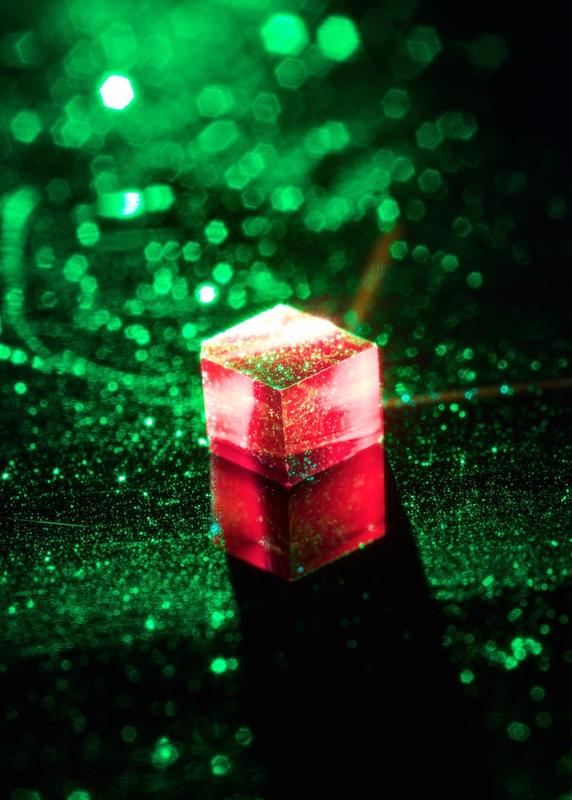Scientists develop a room temperature maser to amplify weak signals

Diamond in a sapphire ring Jonathan Breeze
The abbreviation “Maser” stands for “microwave amplification by stimulated emission of radiation”, i.e. a microwave amplification, which is generated by a stimulated emission of radiation. The physics behind the maser is similar to that of the laser, whose name stands for “light amplification by stimulated emission of radiation”.
Both generate coherent electromagnetic radiation at a single wavelength / frequency. “Until now, masers were mainly used for communication in space, for example to maintain radio contact with the Voyager spacecraft. Because masers can amplify very weak signals almost noise-free this makes them interesting for future communication technologies on Earth”, says Christopher Kay, Professor of Physical Chemistry and Didactics of Chemistry at the University of the Saarland.
A disadvantage of the existing maser technology is that it needs very low temperatures, which could be reached only by the employment of liquid helium. Together with fellow researchers at the London Center for Nanotechnology, Christopher Kay has now developed a maser that can be operated at ambient temperatures. The key to the technology is the use of a sapphire microwave resonator, held in a magnetic field. The resonator confines and concentrates the microwave radiation and thereby it may be amplified it in a phase-stable manner.
The radiation itself is generated by optically exciting “nitrogen vacancy” centers in a diamond. In contrast to pure diamonds, which contain only carbon atoms and are therefore colorless, in the diamond used here a small number of carbon atoms are replaced by a nitrogen atom. The site next to the nitrogen atom, which usually contains one carbon atom, is empty.
“This defect is referred to as an NV (Nitrogen Vacancy) Center and it gives the diamond a purple color. It has a multitude of remarkable quantum properties and is therefore of interest for the development of new technologies, especially for nano applications”, explains Christopher Kay. For example, a maser can be used for more precise measurements in space exploration or nanotechnology, which is often called nanometrology. “Wherever signals with low intensity are to be received, for example, over over long distances and need to be amplified without adding noise, the maser opens up new possibilities,” says Kay.
“It had already been suggested in the scientific community that diamonds with NV centers could be used as the basis for a maser, but the key to our success was to place a diamond in a sapphire resonator”, explains the lead author of the Nature article, physicist Jonathan Breeze of Imperial College, London, adding, “An exciting aspect of this technology is in that the output frequency can be adjusted simply by changing the applied magnetic field. The current device operates at a frequency of 9 GigaHertz (nine billion cycles per second). For comparison, mobile phones work in the two-GigaHertz range. With commercially available magnetic technologies, frequencies up to 200 GigaHertz could be achieved with our room temperature maser.”
As masers use optical photons to generate microwave photons, the researchers expect their work to open new avenues in the fields of diamond quantum technology, magnetic resonance imaging and communications.
The research was supported by the UK Engineering and Physical Sciences Research Council and the Henry Royce Institute.
Original publication in the current issue of “Nature”: Continuous-wave room-temperature diamond maser: www.nature.com/articles/nature25970 (doi:10.1038/nature25970)
Contact:
Prof. Dr. Christopher Kay
Physical Chemistry and Didactic of Chemistry
Tel.: 00 49 681 302 2213
E-Mail: christopher.kay@uni-saarland.de
http://www.nature.com/articles/nature25970
http://www.uni-saarland.de/pressefotos – Press Photos
Media Contact
All latest news from the category: Life Sciences and Chemistry
Articles and reports from the Life Sciences and chemistry area deal with applied and basic research into modern biology, chemistry and human medicine.
Valuable information can be found on a range of life sciences fields including bacteriology, biochemistry, bionics, bioinformatics, biophysics, biotechnology, genetics, geobotany, human biology, marine biology, microbiology, molecular biology, cellular biology, zoology, bioinorganic chemistry, microchemistry and environmental chemistry.
Newest articles

Properties of new materials for microchips
… can now be measured well. Reseachers of Delft University of Technology demonstrated measuring performance properties of ultrathin silicon membranes. Making ever smaller and more powerful chips requires new ultrathin…

Floating solar’s potential
… to support sustainable development by addressing climate, water, and energy goals holistically. A new study published this week in Nature Energy raises the potential for floating solar photovoltaics (FPV)…

Skyrmions move at record speeds
… a step towards the computing of the future. An international research team led by scientists from the CNRS1 has discovered that the magnetic nanobubbles2 known as skyrmions can be…





















